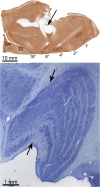Adaptation, perceptual learning, and plasticity of brain functions
- PMID: 28091782
- PMCID: PMC5323482
- DOI: 10.1007/s00417-016-3580-y
Adaptation, perceptual learning, and plasticity of brain functions
Abstract
The capacity for functional restitution after brain damage is quite different in the sensory and motor systems. This series of presentations highlights the potential for adaptation, plasticity, and perceptual learning from an interdisciplinary perspective. The chances for restitution in the primary visual cortex are limited. Some patterns of visual field loss and recovery after stroke are common, whereas others are impossible, which can be explained by the arrangement and plasticity of the cortical map. On the other hand, compensatory mechanisms are effective, can occur spontaneously, and can be enhanced by training. In contrast to the human visual system, the motor system is highly flexible. This is based on special relationships between perception and action and between cognition and action. In addition, the healthy adult brain can learn new functions, e.g. increasing resolution above the retinal one. The significance of these studies for rehabilitation after brain damage will be discussed.
Keywords: Adaptation; Brain plasticity; Motor cortex; Perceptual learning; Rehabilitation; Visual cortex.
Conflict of interest statement
Conflict of interest
All authors certify that they have no affiliations with or involvement in any organization or entity with any financial interest (such as honoraria; educational grants; participation in speakers’ bureaus; membership, employment, consultancies, stock ownership, or other equity interest; and expert testimony or patent-licensing arrangements), or non-financial interest (such as personal or professional relationships, affiliations, knowledge or beliefs) in the subject matter or materials discussed in this manuscript.
Ethical statement
For this type of study formal consent is not required.
Figures








References
Publication types
MeSH terms
Grants and funding
LinkOut - more resources
Full Text Sources
Other Literature Sources
Medical

